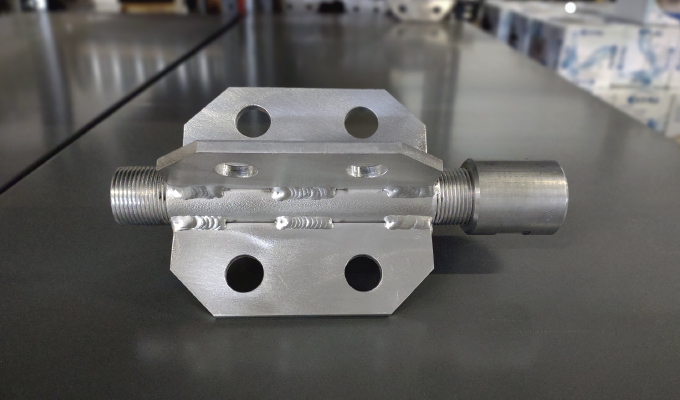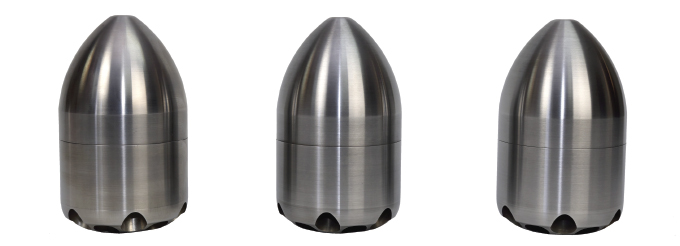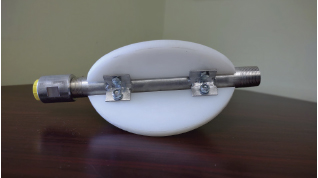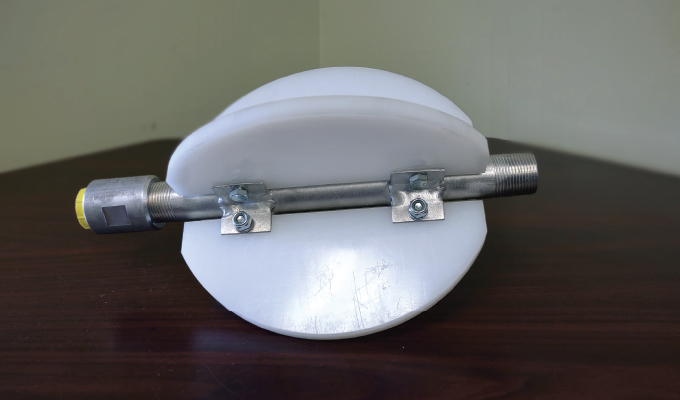For the municipalities and contractors that clean endless miles of sewer lines, the goal has always been to clean more with less effort and fewer resources. Now, the goal is within reach. Innovation in lightweight skid nozzle stabilizing attachments is enabling sewer crews to move up the line more easily than ever, without getting caught on obstructions such as protruding taps, offsets, and deflections.
Today, advancements in skid design can substantially improve the balance and maneuverability of nozzles and hoses to speed up sewer cleaning. When used in conjunction with high-performance nozzles, the combination provides faster cleaning that uses less power, pressure, and water. The approach not only eases operator workloads, but also reduces the cost of vacuum truck fuel, water use, and mechanical wear and tear.

STREAMLINING SEWER CLEANING
When sewer cleaning, a process also called sewer jetting, a high-pressure water hose with a specialized nozzle is placed into the line. Operators release high-pressure water from the sewer truck to dislodge debris and flush it into a manhole. As debris is removed, the hose is pushed deeper into the sewer. Jetting typically involves using between 50 to 85 gallons of water per minute with a 3/4- to 1-inch hose from the truck to flush out debris lodged in the pipe. Operators may also use a vacuum to remove dislodged debris and transfer it to disposal bins.
To maintain stability with the high-volume jetting, operators typically use nozzle skid attachments to keep the nozzle and hose centered within the sewer pipe. Today, some designs go far beyond this basic function and can significantly improve safety and performance.
“More advanced skids with holes are designed to balance the nozzle inside the pipe and prevent the nozzle from becoming airborne and coming out of the manhole. Providing additional holes allows the user to secure the nozzle on the skid while inside the pipe,” says Dan Story, an experienced trainer and operations manager at KEG Technologies, a manufacturer of sewer and storm line products including Tier 1 to Tier 3 nozzles, chain cutters, floor cleaners and camera nozzle systems. The Spartanburg, South Carolina-based company is a member of NASSCO, the National Association of Sewer Service Companies.
The challenge is that traditional skids are often constructed of steel, which adds weight and reduces maneuverability within the sewer line. In response to these challenges, Story sought to ease cleaning sewer lines. Through testing and experimentation, he discovered a specific technology that could have major implications for municipalities and contractors tasked with cleaning more lines with fewer resources.
“I discovered that if I used a high-performance aluminum nozzle with an aluminum skid, I could gain approximately 30 percent more power than typically available through conventional options. That meant I could lower the nozzle flow and pressure and still have all the cleaning power I had before,” says Story.
Story has further refined the skid design after doing additional R&D and testing. The new skid design uses a lightweight aluminum pipe core with protruding plastic fins to provide nozzle stability without the weight of heavier steel skids. The skid design resembles the shape of a “football” to reduce the risk of snagging on sewer pipe obstructions.
“The design lowers the weight and drag of the skid and nozzle in the pipe. The lighter the weight, the easier it is to propel up the line. The ‘football’ shape and the slick plastic fins also reduce friction, allowing the skid to pass over common sewer pipe obstructions, such as protruding taps, offsets, and deflections. If it hits a deflection in a pipe, for instance, it will ‘climb on top’ of the next step and keep on going,” says Story.
The approach enables superior sewer line cleaning with significantly less power, PSI, and water, which translates into some important advantages in the field.

BETTER CLEANING AT LOWER PRESSURE
Cleaning sewer lines at lower pressure reduces the load on vacuum trucks. Toward this end, using a lightweight aluminum skid improves nozzle maneuverability to keep the jetted water stream centered within the pipe and focused where it needs to clean.
When used with a high-performance aluminum nozzle, the combination can produce at least 30 percent more cleaning power than traditional options because it keeps the jetted water stream centered within the pipe and focused where it needs to clean. This reduces pressure and water use while still achieving efficient cleaning. Just as important, it allows the operator to lower the vacuum truck’s RPMs, allowing them to better conserve the vehicle’s fuel use as well as decrease mechanical wear and tear.
“Operators can essentially run the vacuum truck at idle if they are using an aluminum skid and nozzle. They do not have to crank up the truck’s RPMs. Instead, they can effectively clean sewers with as little as 1,000 PSI at 35 gallons a minute. It’s going to be a game changer for cities,” says Story. KEG manufactures sewer cleaning instruments from various materials including aluminum, as is the case with its new skids and assorted nozzles.
Another benefit of sewer cleaning at lower PSI is reducing the risk of “blown toilets,” which can leave sewer material on the floor and toilet seat, upsetting homeowners.
A blown toilet typically occurs when an operator rushes up the sewer line with minimal cleaning on the first pass. This results in excessive debris on the return trip through the same stretch of sewer line. Air flow from the nozzle then compresses between the nozzle and the debris, creating significant positive pressure. When the debris passes by a home’s service line, the pressurized air blasts up and out of the service line, causing a blown toilet.
“When sewer cleaning, lowering the pressure involved reduces the risk of a blown toilet, and can be particularly effective when cleaning shallow manholes, which are more prone to the issue,” says Story.
According to Story, he was able to demonstrate the effectiveness of this technique when a city on the West Coast invited him to do a demonstration for them.
“Previously, the city was challenged with a blown toilet problem at a home that occurred virtually every time they cleaned a certain line. They asked, ‘How can we fix this?’ We went in at 1,000 PSI with an aluminum nozzle and skid and cleaned the entire sewer line without blowing the person’s toilet,” says Story.
Alternatively, the approach can provide more cleaning power on tough jobs such as accumulated grease at restaurants.
“The sewer line on a street with a fast food, hamburger restaurant was full of grease. A municipal supervisor doubted the cleaning effectiveness of using an aluminum skid and nozzle. He couldn’t believe his eyes when the technique quickly liquified the grease,” says Story.

A RANGE OF USES
To accommodate the range of sewer pipes in the field, KEG offers aluminum skids in 6-, 8-, 10-, and 12-inch sizes for use with aluminum Tier 3 nozzles. There are several tiers of nozzles, rated for water efficiency from Tier 1 (about 30 percent efficient), Tier 2 (50 to 60 percent efficient), to Tier 3 (75 to 98 percent efficient).
What sets the most efficient Tier 3 nozzles apart from others in the category is fluid mechanics engineering on a par with the aerodynamics of race cars or jet fighters. In the case of the company’s aluminum Tier 3 nozzles, such as the Royal, Cleaning Torpedo, and Aluminum Traction, the high-performance fluid mechanics design leaves little room for power losses and excessive turbulence.
By more effectively containing, controlling, and directing high-pressure water with less turbulence, an aluminum Tier 3 nozzle can deliver more cleaning power at lower PSI. This eliminates the need for operators to compensate for the lack of power from Tier 1 or 2 nozzles by increasing the pressure to higher PSI on the way back through the line. Ultimately, less PSI (with a better, faster result) facilitates safer, more efficient sewer cleaning that complements the use of an aluminum skid.
As municipalities and contractors seek to easily clean sewer lines with fewer resources, taking advantage of innovative aluminum skids and nozzles that enable superior cleaning at lower pressure with less water will become a best practice strategy.
FOR MORE INFORMATION
Del Williams is a technical writer based in Torrance, California. KEG Technologies Inc. is headquartered in Spartanburg, South Carolina. KEG`s patented fluid mechanics directs high pressure water from a truck or jetter hose in a manner so efficiently they were granted a United States patent, meaning operators can usually clean pipes using less pressure, less fuel consumption, and less time than other less efficient nozzles. For more information, call 866.595.0515 or visit www.kegtechnologies.net.
MODERN PUMPING TODAY, December 2023
Did you enjoy this article?
Subscribe to the FREE Digital Edition of Modern Pumping Today Magazine!


